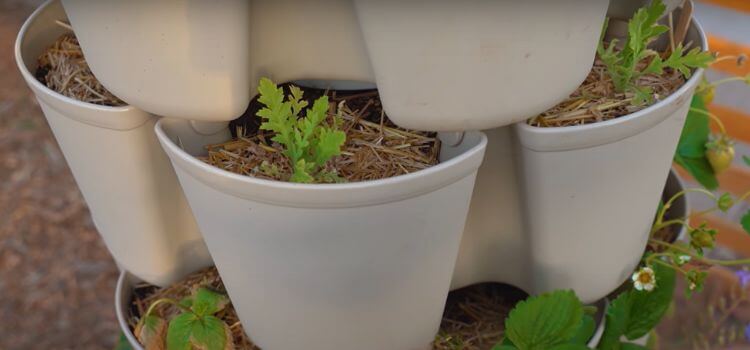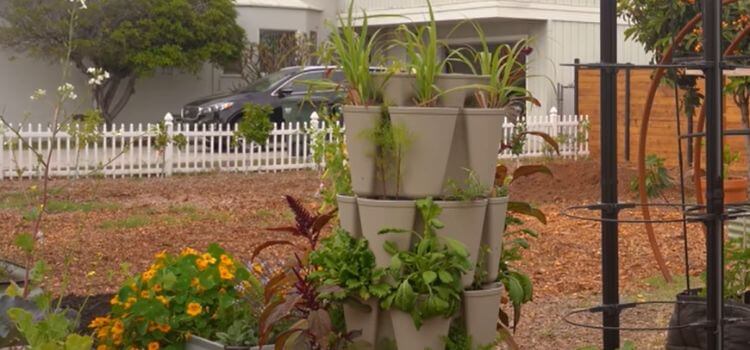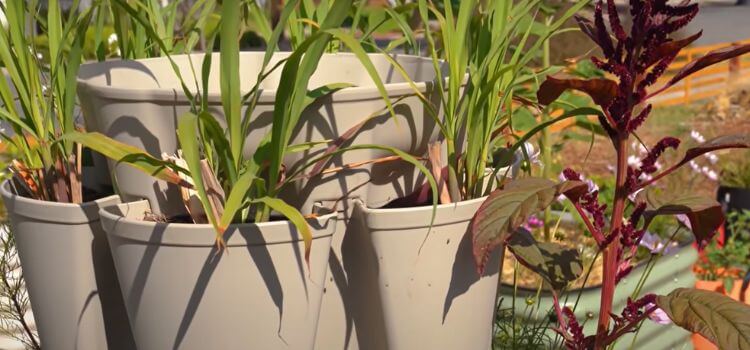As an Amazon Associate, I earn from qualifying purchases.
Vertical gardening involves growing plants upward using structures like trellises or towers. It maximizes space and enhances urban gardening.
Vertical gardening is an innovative method for growing plants in a vertical space. This technique is perfect for urban areas where horizontal space is limited. It enables gardeners to cultivate various plants in small spaces, including vegetables, herbs, and flowers.
Vertical gardens can be created using walls, trellises, or specialized vertical planters. They save space, improve air quality, and add aesthetic value to any environment. This approach to gardening is eco-friendly and helps reduce the urban heat island effect. Vertical gardening is a sustainable and efficient way to bring greenery into your home or office.
What Is Vertical Gardening?
Vertical gardening is a modern technique involving growing plants on a vertically suspended panel. This method is ideal for urban environments with limited space. Plants can be grown on walls, fences, and other vertical structures, making it a versatile solution for garden enthusiasts. Vertical gardens can be simple or complex, depending on the gardener’s needs and creativity. Using vertical space efficiently allows gardeners to maximize their planting area. Vertical gardening is not only functional but also aesthetically pleasing. It adds a touch of greenery to any space, large or small.

Key Features
Vertical gardening offers several unique features:
- Space Efficiency: Utilizes vertical space, ideal for small areas.
- Versatility: Suitable for various structures such as walls, fences, and trellises.
- Accessibility: Easier to maintain as plants are at eye level or higher.
- Design Flexibility: Allows for creative layouts and designs.
Some vertical gardening systems include:
| System Type | Description |
|---|---|
| Living Walls | Panels of plants grown vertically, often with built-in irrigation. |
| Vertical Planters | Stacked containers that hold soil and plants. |
| Hydroponic Towers | Uses water and nutrients to grow plants without soil. |
Benefits Of Vertical Gardening
Vertical gardening provides numerous benefits:
- Maximizes Space: Perfect for urban settings with limited ground area.
- Improves Air Quality: Plants filter pollutants and produce oxygen.
- Enhances Aesthetics: Adds beauty and greenery to urban environments.
- Reduces Heat: Plants can cool the area by providing shade and releasing moisture.
Additionally, vertical gardens can:
- Encourage Biodiversity: Attract various insects and birds.
- Boost Mental Health: Green spaces reduce stress and improve mood.
- Grow Fresh Produce: Ideal for growing herbs, vegetables, and fruits in small spaces.
These benefits make vertical gardening an attractive option for many. It’s a sustainable and practical way to bring nature into urban settings.
Types Of Vertical Gardens
Vertical gardening is a creative way to grow plants upwards. It is perfect for small spaces and uses structures like walls or fences. Vertical gardens add beauty and greenery to urban areas. There are different types of vertical gardens, each with its unique features and benefits.

Living Walls
Living walls, also known as green walls, are covered with plants and can be installed indoors or outdoors. They help improve air quality, provide insulation, and reduce noise. These walls consist of a frame, growing medium, and irrigation system. Plants are placed in the growing medium, and the irrigation system keeps the plants hydrated.
There are different types of growing mediums:
- Soil-based medium
- Hydroponic medium
- Fabric-based medium
Living walls are suitable for various plants. Some popular choices are:
- Ferns
- Mosses
- Succulents
- Herbs
Living walls are not just beautiful. They also offer many environmental benefits. They help reduce the urban heat island effect, provide habitats for birds and insects, create a calming atmosphere, and enhance well-being.
Vertical Planters
Vertical planters are containers arranged vertically. They can be placed on walls, fences, or stands. Vertical planters are easy to set up and maintain. They are perfect for growing herbs, flowers, and small vegetables. These planters come in various materials:
- Plastic
- Wood
- Metal
Some vertical planters have built-in irrigation systems, which ensure that plants get enough water. They can be customized to fit any space, and they are ideal for balconies and patios. Vertical planters help to save space and maximize growing areas, and they also add a touch of greenery to any environment.
Here are some popular types of vertical planters:
- Stacked planters
- Pocket planters
- Pallet planters
Vertical planters are affordable and versatile. They make gardening accessible to everyone. Kids and adults can enjoy growing plants with vertical planters. These planters are a great way to bring nature into urban settings.
Why Try Vertical Gardening?
Vertical gardening is a great way to grow plants in small spaces. It lets you make the most of walls, fences, and other vertical surfaces. This gardening method is ideal for urban areas where space is limited. It can transform a dull wall into a vibrant green space. Vertical gardens can be both beautiful and functional.
Types Of Plants For Vertical Gardens
Many plants do well in vertical gardens. Here are some excellent choices:
- Herbs like basil, mint, and thyme
- Leafy greens such as lettuce and spinach
- Flowers like petunias and begonias
- Vines such as ivy and jasmine
How To Build A Vertical Garden
Building a vertical garden is simple:
- Choose a location that gets enough sunlight.
- Select a structure to support your plants. This can be a trellis, wall-mounted planters, or a vertical garden kit.
- Prepare the soil and plant your chosen plants.
Water your plants regularly and ensure they get enough light.
Choosing The Right Plants
Vertical gardening allows you to grow plants in small spaces. This method uses vertical structures or supports. Choosing the right plants is crucial. It would help if you had plants that thrive in vertical environments. Some plants are better suited for this style.
Best Plants For Vertical Gardens
Certain plants do very well in vertical gardens. Vines are an excellent choice because they climb naturally. Herbs like basil, parsley, and thyme are ideal. Leafy greens such as lettuce and spinach also thrive. Strawberries can be grown vertically, saving ground space.
- Vines: Climbing plants like ivy and morning glory.
- Herbs: Easy to grow and maintain.
- Leafy Greens: Quick-growing and space-saving.
- Strawberries: Perfect for vertical planters.
Flowering plants like petunias and pansies add beauty. Succulents are low-maintenance and ideal for vertical gardens. Ferns do well in shaded vertical gardens. Tomatoes and peppers can also be grown vertically with support.
| Plant Type | Examples |
|---|---|
| Vines | Ivy, Morning Glory |
| Herbs | Basil, Parsley, Thyme |
| Leafy Greens | Lettuce, Spinach |
| Flowers | Petunias, Pansies |
| Succulents | Various Types |
| Ferns | Various Types |
| Fruiting Plants | Tomatoes, Peppers, Strawberries |
Seasonal Considerations
Climate affects plant choices in vertical gardening. Spring is excellent for planting vines and herbs. Leafy greens grow best in cooler seasons. Strawberries also prefer the cool spring weather.
Summer is ideal for flowering plants like petunias. Succulents thrive in the hot, dry summer. Tomatoes and peppers also do well in the summer heat. Ferns prefer shaded areas and can be planted in both spring and summer.
Fall is a good time for planting leafy greens again. Herbs can be grown in the fall for a second harvest. Fruiting plants like tomatoes and peppers may continue to produce. Succulents can still thrive in the fall.
Winter is challenging for many plants. With care, ferns and some succulents can survive. Indoor vertical gardens can help extend the growing season. Use grow lights and maintain a warm environment.
Designing Your Vertical Garden
Vertical gardening is a fun way to grow plants in small spaces. Designing your vertical garden can be a creative and fulfilling project. It lets you make the most out of limited space and bring nature closer to your home. Whether you live in an apartment or have a small yard, vertical gardening can add life and color to any area.
Layout Ideas
Planning the layout of your vertical garden is crucial. Here are some layout ideas to get you started:
- Use trellises to support climbing plants like beans and cucumbers.
- Install wall planters for herbs and flowers.
- Hang baskets from the ceiling for trailing plants.
Another popular layout idea is the pallet garden. Wooden pallets are easy to find and can hold small pots. They can be leaned against a wall or even mounted for a stylish look.
Vertical towers are also a great option. These towers can be stacked with multiple layers of plants. They save a lot of space and look impressive.
Consider using different containers, such as old bottles, shoe organizers, or even gutters. These can be attached to walls or fences to create a unique garden space.
Color Schemes
Choosing a suitable color scheme can make your vertical garden look stunning. Here are some tips for selecting colors:
- Use contrasting colors to make sure plants stand out.
- Stick to a monochromatic scheme for a calm and cohesive look.
- Mix warm and cool colors to create a balanced effect.
For a vibrant garden, choose flowers with bright colors like reds, yellows, and oranges. These colors are eye-catching and can make your garden pop.
Cool colors like blues and purples can create a soothing atmosphere, making them great for a relaxing garden space.
Neutral colors like whites and greens can add elegance and simplicity. They can serve as a backdrop for more colorful plants.
Experiment with different combinations to see what looks best. Remember to consider the colors of your pots and containers, too. They can enhance the overall aesthetic of your vertical garden.

How To Grow An Indoor Vertical Garden
Vertical gardening is a great way to grow plants in small spaces. This method can transform any dull wall into a lush green area. You only need a few supplies and some creativity to get started. Follow these simple steps to create your indoor vertical garden.
Select plants that thrive indoors with minimal sunlight. Good choices include ferns, pothos, and succulents. Herbs like basil and mint also do well indoors. Consider plant size and growth rate to fit your vertical garden space.
Setting Up Your Vertical Garden
Choose a sturdy wall or surface to mount your garden. Install brackets or shelves to hold the pots securely. Use lightweight soil to make it easier for the plants to grow. Ensure proper drainage to prevent waterlogging.
Watering And Maintenance
Water your plants according to their specific needs. Some plants need water daily, while others require less frequent watering. Check the soil moisture to avoid overwatering. Trim the plants regularly to maintain their shape and size.
Using Vertical Garden Kits
Vertical garden kits are available for easy setup. These kits include all necessary components, such as pots, brackets, and soil. Follow the instructions provided in the kit for a hassle-free experience. Kits are ideal for beginners starting their vertical garden journey.
Urban Vertical Gardening
Vertical gardening is growing plants on walls or other vertical surfaces. This technique is perfect for urban areas where space is limited. It allows city dwellers to enjoy greenery and fresh produce without needing large plots of land. It transforms dull walls into vibrant gardens and helps improve air quality.
Space Optimization
Urban spaces often need to be fixed. Vertical gardening provides an intelligent solution to this problem. Growing plants vertically maximize the use of available space. This method is ideal for small apartments and balconies. You can create a lush garden in a tiny area by using walls and fences.
Some benefits of space optimization through vertical gardening include:
- Increased planting area: Use vertical space to grow more plants.
- Improved air circulation: Plants at different heights improve airflow.
- Enhanced aesthetics: Vertical gardens make spaces look beautiful.
Different techniques help optimize space. Vertical planters, hanging baskets, and trellises are popular choices. These tools enable you to grow a variety of plants. Herbs, flowers, and even vegetables thrive in vertical gardens.
Community Gardens
Community gardens in urban areas have gained popularity. These gardens bring people together. They allow neighbors to share a common green space. Vertical gardening plays a crucial role in these gardens. It helps in creating more planting areas in limited spaces.
Advantages of community vertical gardens include:
- Social interaction: People meet and bond over gardening activities.
- Education: Learn about plants and gardening techniques.
- Fresh produce: Grow and share fresh fruits and vegetables.
Community gardens also improve the environment. They reduce the urban heat island effect. Vertical gardens, in particular, help in cooling down buildings. This reduces the need for air conditioning and saves energy. By incorporating vertical gardening, community gardens become more efficient and productive.
Frequently Asked Questions
What Is Vertical Gardening?
Vertical gardening involves growing plants upward on structures. It’s ideal for small spaces. It maximizes the use of vertical space.
How To Start A Vertical Garden?
Choose a suitable wall or frame. Select plants that thrive vertically. Ensure proper sunlight and water.
What Are The Benefits Of Vertical Gardening?
Vertical gardening saves space and improves air quality. It also enhances aesthetics and promotes healthier plants.
Which Plants Are Best For Vertical Gardens?
Herbs, succulents, and small vegetables thrive. Consider strawberries, tomatoes, and ferns as well. They grow well vertically.
Conclusion
Vertical gardening transforms small spaces into lush, productive areas. It’s eco-friendly and great for urban living. Start your green journey today. Enjoy fresh produce, improve air quality, and beautify your home. Give vertical gardening a try and experience the benefits firsthand.
Happy gardening!

